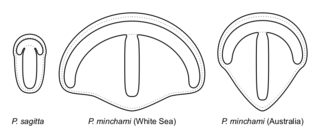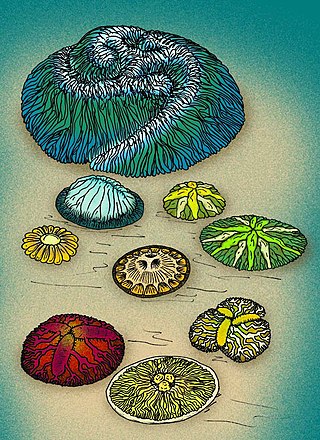
Dickinsonia is a genus of extinct organism, most likely an animal, that lived during the late Ediacaran period in what is now Australia, China, Russia, and Ukraine. It is one of the best known members of the Ediacaran biota. The individual Dickinsonia typically resembles a bilaterally symmetrical ribbed oval. Its affinities are presently unknown; its mode of growth has been considered consistent with a stem-group bilaterian affinity, though various other affinities have been proposed. It lived during the late Ediacaran. The discovery of cholesterol molecules in fossils of Dickinsonia lends support to the idea that Dickinsonia was an animal, though these results have been questioned.

Kimberella is an extinct genus of bilaterian known only from rocks of the Ediacaran period. The slug-like organism fed by scratching the microbial surface on which it dwelt in a manner similar to the gastropods, although its affinity with this group is contentious.

Tribrachidium heraldicum is a tri-radially symmetric fossil animal that lived in the late Ediacaran (Vendian) seas. In life, it was hemispherical in form. T. heraldicum is the best known member of the extinct group Trilobozoa.

Yorgia waggoneri is a discoid Ediacaran organism. It has a low, segmented body consisting of a short wide "head", no appendages, and a long body region, reaching a maximum length of 25 cm (9.8 in). It is classified within the extinct animal phylum Proarticulata.

Cephalonega stepanovi is a fossil organism from Ediacaran deposits of the Arkhangelsk Region, Russia. It was described by Mikhail A. Fedonkin in 1976

Rangea is a frond-like Ediacaran fossil with six-fold radial symmetry. It is the type genus of the rangeomorphs.

Parvancorina is a genus of shield-shaped bilaterally symmetrical fossil animal that lived in the late Ediacaran seafloor. It has some superficial similarities with the Cambrian trilobite-like arthropods.

Vendia is a genus of oval-shaped, Ediacaran fossils ranging from 4.5 to 12.5 mm long. The body is completely segmented into isomers, which are arranged alternately in two rows longitudinal to the axis of the body. The larger isomers cover the smaller ones externally but the posterior ends of all the isomers remain free. The transverse elements decrease in size from anterior to posterior and are all inclined in the same direction.

Trilobozoa is a phylum of extinct, sessile animals that were originally classified into the Cnidaria. The basic body plan of trilobozoans is often a triradial or radial sphere-shaped form with lobes radiating from its centre. Fossils of trilobozoans are restricted to marine strata of the Late Ediacaran period.

Albumares brunsae is a tri-radially symmetrical fossil animal that lived in the late Ediacaran seafloor. It is a member of the extinct group Trilobozoa.
Anfesta stankovskii is a tri-radially symmetrical fossil animal that lived in the late Ediacaran (Vendian) seafloor. It is a member of the extinct group Trilobozoa.

Proarticulata is a proposed phylum of extinct, near-bilaterally symmetrical animals known from fossils found in the Ediacaran (Vendian) marine deposits, and dates to approximately 567 to 550 million years ago. The name comes from the Greek προ = "before" and Articulata, i.e. prior to animals with true segmentation such as annelids and arthropods. This phylum was established by Mikhail A. Fedonkin in 1985 for such animals as Dickinsonia, Vendia, Cephalonega, Praecambridium and currently many other Proarticulata are described.

Vendiamorpha is a class of extinct animals within the Ediacaran phylum Proarticulata.
Vaveliksia is an extinct genus of Ediacaran Sponge-like organism with a long, tubular-shaped body and a attachment disk similar to that of Petalonamids. The Vaveliksia genus contained two species, Vaveliksia velikanovi as well as Vaveliksia vana. The two species vary in appearance to one another, with V. velikanovi having a more tubular-shaped, sack-like morphology with a crown of wrinkles on top of one of its ends as well as possessing a much more disk-like holdfast with V. vana having an appearance more similar to that of a Poriferan, with V. vana having a much more dome-shaped holdfast and a capsule-like body with no crown of wrinkles unlike V. velikanovi.

Andiva ivantsovi is a Vendian fossil, identified to be a bilaterian triploblastic animal in the Ediacaran phylum Proarticulata, known from the Winter Coast, White Sea, Russia. It was first discovered in 1977, and described as a new species in a new genus by Mikhail Fedonkin in 2002. It lived about 555 million years ago. Fossils of Andiva also occur in South Australia. All known fossils of Andiva are external molds.

Solza margarita is an extinct animal of uncertain phylogeny which lived about 555 mya in the Ediacaran period.

Ventogyrus is an Ediacaran fossil found in the White Sea-Arkhangelsk region of Russia. It was first discovered in the Teska member of the Ust'-Pinega formation, in a thick lens of sandstone, originally sand dumped by storm waves that cut a deep channel through the shallow sea bottom where the organisms lived. Many individuals were preserved on top of each other, often torn or in distorted positions. As a result, it was originally thought to have had a "boat shaped" form and to have lived anchored in the sea floor. However, a nearby site discovered later by Mikhail Fedonkin yielded separate specimens which were beautifully preserved in an upright position and showed the internal anatomy.

Temnoxa molluscula is a small creature approximately 8 mm wide found in the Ediacaran period in Russia. The Temnoxa has a resemblance to a vertically cut penny bun mushroom. Due to the lack of information regarding the fossils of this organism, researchers are unable to place Temnoxa molluscula into any known phylum. The genus was originally discovered by Russian paleontologist Andrey Yu. Ivantsov in 2004.

Cephalozoa are an extinct class of primitive segmented marine organisms within the Phylum Proarticulata from the Ediacaran period. They possessed bilateral symmetry and were characterized by a thin, rounded body.












